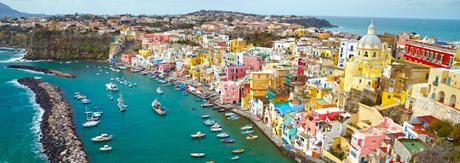
Ancient Naples (Circa 600BC)
Around 600BC, the Cumae people who were a part of the Greek Islands construct a colony which they name ‘Neapolis’ meaning new city. It was then conquered by the Romans in 326BC however the Greek culture and language still flourished with Romans constructing villas along the Bay of Naples which acted as a sort of resort town. The city thrived and was much like Pompeii in that it was adorned with temples and statues along the streets. It was also under Roman rule that Christianity made its way to Naples. However, after the fall of the Roman Empire in the 5th century AD, the Byzantine Empire laid siege on Naples, claiming the city for its own. When this occurred, Naples becomes a duchy and life continued for its inhabitants enjoying some of their same freedoms. The hold that the Byzantine Empire had on Naples slowly loosened and in 645AD a local to the area named Basilio becomes the Duke of Naples allowing the city to thrive again independently.
Medieval (1100-1400)
In the early to mid-12th century, the Normans invade Naples on their quest to control all of Southern Italy and Naples joins the Kingdom of Sicily where it enjoys some of its past flourishing, even though it was now the city of Palermo that was taking center stage. It’s during this time that a university is founded in Naples, but it isn’t long till once more Naples is taken over by the King of Anjou, a providence of France. During this time, Naples enters a medieval golden age and many constructions of churches and castles are built. In 1442 Spain takes over Naples, and there it remains in the Spanish Empire until the 18th century.
Renaissance (1600s)
In 1647, Naples was under Spanish rule, and the people were struggling immensely under a fruit tax that had been introduced in the same year. On the 7th of July a riot breaks out in the Piazza del Mercato, led by none other than a local fisherman named Tommaso Aniello. He had no further issues with the Spanish other than the fruit tax, but the riot grew a life of its own and on the 16th of July, was murdered by extremists who were on his side, at the Chiesa di Santa Maria del Carmine. It took until the next year that order was once again seized by the Spaniards and the rebels were executed. Once more, life returned to normal for the people of Naples.
Modern Naples (1700-1945)
In the 1700s the French had created a republic in Naples and the city was flourishing. This remained until 1815 when Napoleon Bonaparte was defeated, and the Kingdom of Sicily was once again seated at the head of the city. This time, the King administered a repressive regime to the people and many rebellions were fought and lost during the 1800s. It wasn’t until 1860 that the famed soldier Garibaldi made his way to Naples and unified Italy. Soon after, cholera sweeps through the city slums and the state of the city becomes poor. Furthermore, the city suffers greatly after heavy bombings in World War 2 and an invasion from German forces. It takes a group of locals and ex-soldiers who eventually drive the Nazi’s out of Naples, making way for the U.S Allied forces.
Today, after a tumultuous history, Naples thrives once more with a population of almost one million people. The city is a popular stop over and gateway to the Amalfi Coast and the ruins of Pompeii and Herculaneum. The culture of Naples, its food and people are all a blend of many past cultures that all made their way through the city once upon a time in history which makes it the perfect holiday destination if you’re after an authentic Italian experience.
Naples, Today
Located 185 kilometres southwest of Rome lies the third most populous cities in Rome. Naples is home to an important seaport and is the largest city of the Campania region. Behind the city rests Mt. Vesuvius, perhaps one of the most iconic volcanoes in the world, which threatens to erupt at any moment. However, the soul of Naples, in all its chaotic beauty has been around long enough that a volcanic eruption is usually the last thing on the minds for locals who have populated the city for over 2,000 years. With invasions and power changes, the city is a diverse canvas for architecture made popular throughout the ages. From Baroque to Renaissance, Gothic to Classical, the beauty of Naples is that a walk through the streets is like a step back into different eras of history.
And then there’s pizza. As the birthplace of the delicious food item beloved by people worldwide, Naples has earned quite a reputation of having the best in the world. The world’s first pizzeria; Antica Pizzeria Port’ Alba was established in 1830 so if ever you find yourself in Naples, do make it your goal to try one of the pizzas here! The history of the city is rich and dense, but it can be understood by going through relevant moments of the past to key events that shaped the city.

